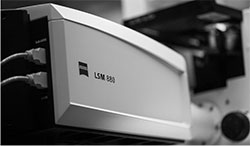Edward N. Pugh, Jr., Ph.D.

Distinguished Professor
3301C Tupper Hall
Davis Campus
530-752-1468
enpughjr@health.ucdavis.edu
Lab Website
Research Interests
My research program has for many years investigated phototransduction, the molecular and biophysical mechanisms by which rod and cone photoreceptors in the retina transduce light into electrical signals. In the past decade it has focused on phototransduction in mouse cone photoreceptors. Ours was the first laboratory to develop a method for recording the light-driven currents of single mouse cones, and with this method and with cone-specific field potentials (electroretinography) which we also pioneered, we established a number of distinctive features of mouse cones. These include the functional co-expression of both mouse cone opsins (S- and M-) in most cones, the requirement for the G-protein receptor kinase Grk1 (formerly “rhodopsin kinase”) in cone opsin deactivation, and the functional co-expression of two arrestins (Arr1, Arr4), establishing that at least one of the arresting be present for normal deactivation of both S- and M-opsin.
Recently, we created an S-opsin knockout mouse line, and two S-opsin knockin (F81Y, E108Q) mice. The S-opsin knockout mouse has revealed a competitive inhibition between S- and M-opsin mRNA during translation in cones that co-express both opsins, and has provided an invaluable control for many experiments in which we assess biochemical and histological properties of S-opsin.
The F81Y knockin mouse has a surprising phenotype: though the point mutation shifted the λmax from 360 nm to 420 nm, it also led to 2- to 3-fold reduced expression, which we have shown is due to ER-associated degradation, which can be completely reversed by increasing 11-cis retinal exogenously. This has led to novel insight into the regulation of cone opsin expression, which we are pursuing vigorously, using AAV-delivery of fluorescent-protein tagged S-opsin DNA, and a variety of optogenetic reporters.
In the past eight years my laboratory has moved increasingly toward the use of two-photon (2P) imaging of live retina, after the construction of a 2P microscope suitable for working in live retina. It is impossible to investigate normal retinal function with 1P imaging, because the rods and cones are too sensitive to visible light. The infra-red spectral content of the Ti:Sapphire excitation beam in the 2P microscope is thus absolutely essential. We are also working on mouse models of degenerative disease involving cone opsins.
Graduate Group Affiliations
An updated list of current publications: PubMed | Google Scholar
Insinna C, Daniele LL, Davis JA, Larsen DD, Kuemmel C, Wang J, Nikonov SS, Knox BE, Pugh EN Jr. “An S-Opsin knock-in mouse (F81Y) reveals a role for the native ligand 11-cis-retinal in cone opsin biosynthesis”. Journal of Neuroscience 2012 Jun 6;32(23), 8094-9104. (PMCID: PMC3381355)
Gross, O.G., Pugh, Jr. E.N. “Spatiotemporal cGMP dynamics in living mouse rods”. Biophysical Journal 2012 Apr 18;102, 1775-1784 (PMCID:PMC3328695)
Daniele LL, Insinna C, Chance R, Wang J, Nikonov SS, Pugh EN Jr. “A mouse M-opsin monochromat: retinal cone photoreceptors have increased M-opsin expression when S-opsin is knocked out”. Vision Research 2011 Feb 23;51(4):447-58. (PMCID: PMC3072795)
Naarendorp, F., Esdaille,T.M, Banden, S.M., Andrews-Labenski, J., Gross, O.P. and Pugh, Jr., E.N. “Dark light, rod saturation and the absolute and incremental sensitivity of mouse cone vision”. Journal of Neuroscience 2010 Sep 15;30(37), 12495-12507. (PMID: 20844144; PMCID in progress)
Burns, M.E. and Pugh, Jr. E.N. “Lessons from photoreceptors: turning off G-protein signaling in living cells”. Physiology 2010 Apr;25, 72-84. (PMCID: PMC2880230)
Calvert, P.D., Schiesser, W.E. and Pugh, Jr., E.N. “Diffusion of a soluble protein, photoactivatable GFP, through a sensory cilium”. Journal of General Physiology, 135, 173-196. (PMCID: PMC2828910)
Ng, L., Lyubarsky, A.L., Nikonov, S.S., Ma, M., Srinivas, M., Kefas, B., St. Germain, D.L., Hernandez, A., Pugh, Jr., E.N. and Forrest, D. “Type 3 deiodinase, a thyroid hormone-inactivating enzyme, controls survival and maturation of cone photoreceptors”. Journal of Neuroscience, 2010 Mar 3;30(9), 3347-3357. (PMCID: PMC2843520)
Burns, M.E. and Pugh, Jr. E.N. “RGS9 concentration matters in rod phototransduction”. Biophysical Journal, 2009 Sep 16;97, 1538-1547. (PMCID: PMC2749774)
Nikonov, S. S. Brown, B.M., Davis, J.A., Zuniga, F.I., Bragin, A., Pugh, Jr., E.N. and Craft, C.M. “Mouse cones require an arrestin for normal inactivation of phototransduction”. Neuron, 2008 Aug 14;59, 462-474. (PMCID: PMC2610856)
Calvert, P.D., Peet, J.A., Bragin, A., Schiesser, W.E. and Pugh, Jr., E.N. “Fluorescence relaxation in 3D from diffraction-limited sources of PAGFP or sinks of EGFP created by multiphoton photoconversion”. Journal of Microscopy, 2007 Jan;225 (1), 49-71. (PMCID: PMC2828910)
Nikonov, S. S., Kholodenko, R., Lem, J and Pugh, Jr., E.N. “Physiological features of the S- and M-cone photoreceptors of Wild-type mice from single-cell recordings”. Journal of General Physiology, 2006 Apr;127(4), 359-374. (PMCID: PMC2151510)
Peet, J.A., Bragin, A., Calvert, P.D., Nikonov, S.S., Mani, S., Zhao, J., Besharse, J.C., Pierce, E.A., Knox, B. and Pugh, Jr., E.N. “Quantification of the cytoplasmic spaces of living cells with EGFP reveals Arrestin-EGFP to be in disequilibrium in dark adapted rod photoreceptors”. Journal of Cell Science 2004 Jun 15;117(14), 3049-3059. (PMID: 15197244)
Lamb, T.D. and Pugh, Jr., E.N. “Dark adaptation and the visual retinoid cycle of vision”. Progress in Retinal and Eye Research 2004 May;23, 307-380. (PMID: 15177205)
Sokolov, M., Lyubarsky, A.L, Strissel, K.J., Savchenko, A., Govardovskii, V.I. Pugh, Jr., E.N. and Arshavsky, V.Y. “Massive light-dependent translocation of transducin between the functional compartments of rod photoreceptors: a novel mechanism of light adaptation”. Neuron, 2002 Mar 28;33, 95-106. (PMID: 11931744)
Nikonov, S.S., Lamb, T.D. and Pugh, Jr., E.N. “The role of steady phosphodiesterase activity in the kinetics and sensitivity of the light-adapted salamander rod photoresponse”. Journal of General Physiology, 2000 Dec;116, 795-824. (PMID: 11099349)
Nikonov, S., Engheta, N. and Pugh, Jr. E.N. “The kinetics of recovery of the dark-adapted salamander rod photoresponse”. Journal of General Physiology, 1998 Jan;111, 7-38. (PMID: 9417132)
Pugh, Jr., E.N. and Lamb, T.D. “Amplification and kinetics of the activation steps in phototransduction”. Biochimica et Biophysica Acta, Reviews in Bioenergetics, 1993 Mar 1;1141, 111-149. (PMID: 8382952)
- Research Career Development Award, National Eye Institute of the NIH
- Troland Research Award, National Academy of Sciences
- Jules and Doris Stein Research to Prevent Blindness Professorship
- Alcon Research Award for Outstanding Contribution to Vision Research, Alcon Research Institute
- Proctor Medal of the Association for Research in Vision and Ophthalmology (with T. D. Lamb)
- Journal of General Physiology, Editorial board; Editor-in-chief




 Make a donation using our secure online system.
Make a donation using our secure online system.